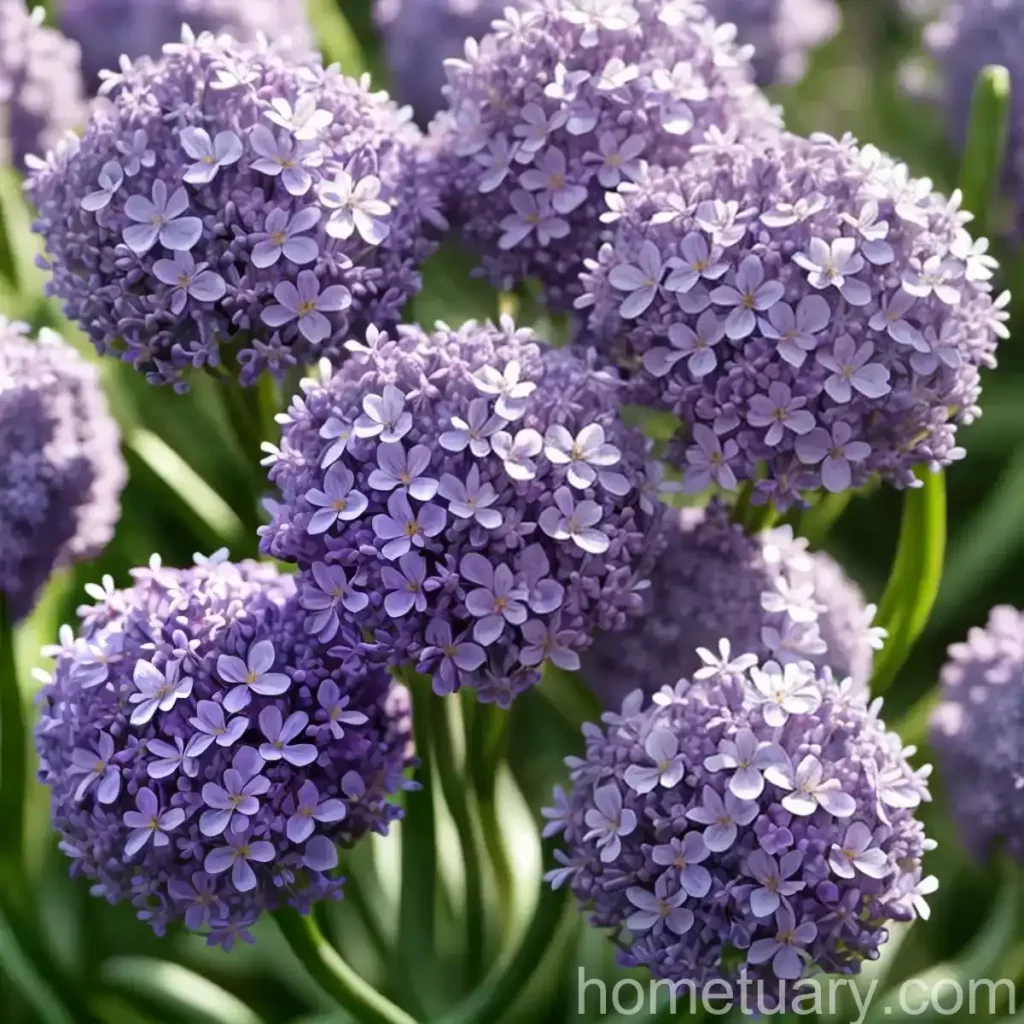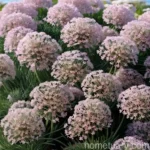The Beautiful and Versatile Thrift (Armeria pseudarmeria ‘Ballerina Lilac’)
Plants are fascinating organisms that play a critical role in our environment and provide numerous benefits to human society. Whether for their aesthetic appeal, ecological significance, or practical uses, plants enrich our lives in countless ways. In this comprehensive guide, we will delve into the enchanting world of the thrift (Armeria pseudarmeria ‘Ballerina Lilac’). We will explore its characteristics, cultivation, uses, and much more, offering valuable insights into this remarkable plant.
What is “Thrift” (Armeria pseudarmeria ‘Ballerina Lilac’)
The thrift, scientifically known as Armeria pseudarmeria ‘Ballerina Lilac’, is a captivating perennial plant that belongs to the Plumbaginaceae family. This species is highly regarded for its attractive flowers and low-growing habit, making it a popular choice for gardeners seeking versatile and visually appealing additions to their landscapes.
The “Ballerina Lilac” variety of Armeria pseudarmeria is particularly esteemed for its charming lilac-colored flowers, which add a delicate and elegant touch to any garden setting. This cultivar is celebrated for its resilience and adaptability, thriving in various environmental conditions and enhancing the aesthetic appeal of outdoor spaces.
Key Takeaways – Thrift (Armeria pseudarmeria ‘Ballerina Lilac’)
Before we delve into the intricacies of cultivating and caring for the thrift (Armeria pseudarmeria ‘Ballerina Lilac’), let’s highlight some key takeaways about this remarkable plant:
- Thrift (Armeria pseudarmeria ‘Ballerina Lilac’) is a perennial plant known for its ornamental lilac-colored flowers.
- It is a low-growing species, making it suitable for edging, borders, and ground cover in garden landscapes.
- Thrift is a drought-tolerant plant, ideal for environments with limited water availability.
- The Ballerina Lilac variety of Armeria pseudarmeria is an attractive option for low-maintenance gardeners seeking resilient and visually appealing plants.
- With its compact growth habit and evergreen foliage, Thrift is a versatile plant that is well-suited for various garden styles and designs.
Now that we have a brief overview of the “Ballerina Lilac” thrift, let’s dive deeper into the specific aspects of its cultivation, care, and uses.
Cultivation of Thrift (Armeria pseudarmeria ‘Ballerina Lilac’)
Water
Thrift plants, including the Ballerina Lilac variety, are renowned for their drought tolerance. While they appreciate well-drained soil, they can withstand periods of dryness, making them excellent choices for water-wise gardening and xeriscaping projects. When establishing young plants, it is advisable to provide adequate moisture to promote healthy root development. Once established, thrift plants require minimal watering, thriving in arid and semi-arid climates without demanding excessive water supply.
Sunlight
Armeria pseudarmeria ‘Ballerina Lilac’ thrives in full sun to partial shade conditions. Ideally, it should receive at least 6 hours of direct sunlight daily to ensure vigorous growth and abundant flowering. In regions with intense heat, providing some afternoon shade can be beneficial, especially during the peak of summer. However, in cooler climates, full sun exposure is generally well-tolerated by this resilient plant.
Soil
Well-drained, sandy, or loamy soils are preferred by thrift plants. These species are adapted to coastal environments and can tolerate slightly alkaline or acidic soils. When planting Armeria pseudarmeria ‘Ballerina Lilac’, it is essential to amend heavy clay soils with organic matter to improve drainage and create a conducive growing environment. Additionally, adding a layer of mulch around the base of the plant can help retain moisture, regulate soil temperature, and inhibit weed growth.
Fertilizer
Thrift plants are not heavy feeders and can thrive in nutrient-poor soils. However, a balanced, slow-release fertilizer can be applied during the growing season to support healthy growth and prolific flowering. It is recommended to use a fertilizer with a lower nitrogen content to prevent excessive vegetative growth at the expense of flower production. Following the manufacturer’s instructions for application and dosage is crucial to avoid the risk of over-fertilization, which can negatively impact the plant’s health.
Pruning
Pruning thrift plants, including the Ballerina Lilac variety, is relatively straightforward and primarily focuses on maintaining a tidy appearance and promoting continuous blooming. Deadheading spent flowers can encourage the plant to produce new blooms, prolonging the flowering period and enhancing the overall visual appeal. Additionally, removing any yellowing or damaged foliage helps maintain the plant’s vigor and aesthetics.
Propagation
Thrift (Armeria pseudarmeria ‘Ballerina Lilac’) can be propagated through various methods, including division, seeds, and cuttings. Here are the primary propagation techniques for this charming plant:
- Division: When the plant becomes overcrowded and requires rejuvenation, dividing the clumps in early spring can promote healthier growth and the development of new plants.
- Seeds: Collecting seeds from mature flower heads and sowing them in well-prepared soil can yield new seedlings. However, it is important to note that thrift seeds may have variable germination rates and require patience for successful propagation.
- Cuttings: Taking stem cuttings in late spring or early summer and placing them in a well-draining rooting medium can result in the establishment of new plants. Providing the appropriate moisture and warmth during the rooting process is essential for the success of this propagation method.
Container Popularity
Thrift plants, particularly the Ballerina Lilac variety, are well-suited for container gardening. Their compact size, low-maintenance requirements, and attractive flowers make them appealing choices for enhancing outdoor living spaces, balconies, and patios. When selecting containers for Armeria pseudarmeria ‘Ballerina Lilac’, it is important to ensure proper drainage to prevent waterlogging, which can be detrimental to the plant’s health. Additionally, using a well-draining potting mix and providing adequate sunlight can support the thriving of thrift plants in containers.
Uses of Thrift (Armeria pseudarmeria ‘Ballerina Lilac’)
The “Ballerina Lilac” variety of Armeria pseudarmeria offers myriad uses in garden landscapes, thanks to its charming flowers and adaptable nature. Here are some common uses of this versatile plant:
- Edging and Borders: Thrift plants are popular choices for creating neat borders and edging along garden pathways, flower beds, and borders. Their low-growing habit and profusion of flowers add a delightful accent to the landscape, enhancing the overall visual appeal.
- Ground Cover: Due to its compact growth and mat-forming nature, Armeria pseudarmeria ‘Ballerina Lilac’ serves as an excellent ground cover plant, particularly in areas with poor soil quality or limited moisture.
- Container Gardening: The Ballerina Lilac variety is well-suited for container gardening, allowing individuals with limited garden space to enjoy its captivating flowers and evergreen foliage on decks, patios, and balconies.
- Rock Gardens: Thrift plants complement rock garden designs exceptionally well, adding bursts of color and textural interest amid the rocky terrain. Their ability to thrive in well-drained, rocky soils makes them ideal candidates for rock garden plantings.
Common Diseases and Pest Management for Thrift (Armeria pseudarmeria ‘Ballerina Lilac’)
Disease Diagnosis
Thrift plants are generally resilient and disease-resistant, provided that they are grown in suitable environmental conditions. However, they may occasionally encounter certain issues that can affect their health and vigor. Common diseases that may affect Armeria pseudarmeria ‘Ballerina Lilac’ include:
- Powdery Mildew: This fungal disease appears as a powdery, white substance on the plant’s foliage, negatively impacting its aesthetics and overall health.
- Crown Rot: Excessive moisture and poor drainage can lead to crown rot, which manifests as dark, water-soaked lesions at the base of the plant, eventually causing rotting and dieback.
- Leaf Spot: Fungal or bacterial leaf spot diseases may affect the foliage of thrift plants, causing circular or irregular spots, discoloration, and in severe cases, defoliation.
Common Pests
Thrift plants are relatively resistant to pest infestations, but they may occasionally attract certain pests that can impact their vitality. Common pests that may affect Armeria pseudarmeria ‘Ballerina Lilac’ include:
- Aphids: These small, pear-shaped insects may congregate on the plant’s tender growth, sucking sap and causing distortion and discoloration of the affected plant parts.
- Spider Mites: These minuscule pests can infest the plant under hot and dry conditions, causing stippling and webbing on the foliage, leading to reduced vigor and aesthetic appeal.
- Slugs and Snails: These mollusks are attracted to the lush foliage of thrift plants and can cause damage by feeding on leaves and flowers, particularly in moist and shaded environments.
Botanist’s Tips for Cultivating Thrift (Armeria pseudarmeria ‘Ballerina Lilac’)
To ensure the successful cultivation and thriving of Armeria pseudarmeria ‘Ballerina Lilac’, consider the following tips from botanists and experienced gardeners:
- Selecting Well-Drained Sites: When choosing planting locations for thrift, prioritize well-drained sites that prevent waterlogging and promote healthy root development.
- Moderate Fertilization: Avoid over-fertilizing thrift plants, as excessive nitrogen can lead to excessive vegetative growth at the expense of flowering.
- Monitoring Moisture Levels: While thrift plants are drought-tolerant, regular monitoring of moisture levels is important, especially during establishment and prolonged dry spells.
- Pest Vigilance: Keep an eye out for pests such as aphids, spider mites, and slugs, particularly during periods of environmental stress, and take appropriate measures to control infestations.
Fun Facts about Thrift (Armeria pseudarmeria ‘Ballerina Lilac’)
Symbolism and Cultural Significance
- In the language of flowers, thrift is often associated with sentiments of sympathy, admiration, and understanding, making it a meaningful choice for floral arrangements and bouquets.
- In folklore and traditional beliefs, thrift is often regarded as a symbol of modesty, determination, and resilience, reflecting its hardy nature and capacity to thrive in challenging conditions.
Ecological Importance
- Thrift plants, including the Ballerina Lilac variety, are valuable contributors to pollinator habitats, attracting bees, butterflies, and other beneficial insects with their nectar-rich flowers.
- Their low-growing habit and dense foliage provide shelter for small creatures and contribute to the ecological diversity of natural landscapes, particularly in coastal and rocky environments.
Links to External Resources
For readers interested in further exploration of Armeria pseudarmeria ‘Ballerina Lilac’ and related topics, the following resources are recommended:
- Royal Horticultural Society – Armeria pseudarmeria ‘Ballerina Lilac’
- Missouri Botanical Garden – Armeria pseudarmeria ‘Ballerina Lilac’
In conclusion, the thrift (Armeria pseudarmeria ‘Ballerina Lilac’) stands as a delightful testament to the beauty and resilience of plant life. With its ornamental flowers, low-growing habit, and versatility, this charming plant has secured its place as a beloved addition to garden landscapes and horticultural endeavors. By understanding its characteristics, cultivation requirements, and ecological significance, we can fully appreciate the enduring allure of the Ballerina Lilac variety and its contribution to the botanical tapestry of our natural world. Whether adorning gardens, attracting pollinators, or symbolizing cherished sentiments, thrift plants continue to captivate and enchant enthusiasts and admirers worldwide.















